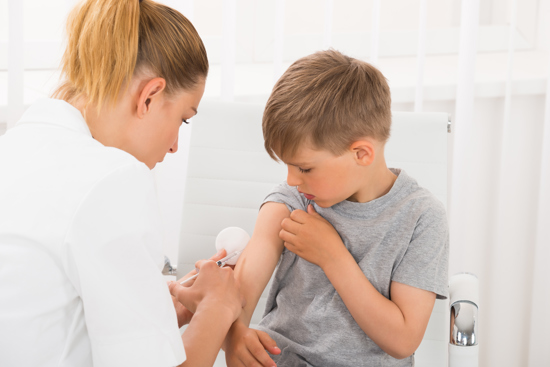The vaccine against diphtheria, tetanus, pertussis and poliomyelitis is given as a four-component vaccine. Vaccines against the four diseases are given at the same time so the child only needs one injection in the upper arm.
About the diseases the vaccine protects you from
Diphtheria
Diphtheria is an acute infection in the upper airways caused by diphtheria bacteria. The bacteria produce toxins that can cause major swelling in the mucous membranes of the throat which makes it difficult to breath. The toxins may also attack the heart, kidney and nervous tissue.
The disease can be fatal. During and just after the Second World War, there were diphtheria epidemics in Norway. After vaccination was introduced in 1952, only a few cases of the disease have occurred after infection abroad. Diphtheria continues to occur in parts of Europe and other parts of the world.
Tetanus
Tetanus is caused by a bacterium found in soil. Infection can occur when the bacterium comes into contact with wounds. The disease is not transmitted from person to person.
The bacterium produces toxins that attack the nervous system and cause muscle stiffness and painful cramps. The disease has high mortality. It is less common in the Nordic countries than in warmer climates.
Whooping Cough (pertussis)
Whooping Cough (pertussis) is a prolonged (6–12 weeks) respiratory infection with severe bouts of coughing. Whooping cough can lead to brain damage due to lack of oxygen during coughing bouts, and in rare cases to death.
It can be particularly dangerous for small children, particularly infants. In older children and adults, the disease can be prolonged and bothersome, but is rarely life-threatening. The disease is highly contagious – nearly 100 per cent of the population contracted the disease before we began to vaccinate.
Poliomyelitis
Poliomyelitis is a viral disease that usually results in cold-like symptoms, body aches or diarrhoea. It can cause inflammation of the brain membrane (meningitis) and can lead to permanent paralysis. Fatalities do occur.
Before the vaccine arrived in 1956, there were annual polio epidemics in Norway in which several hundred children and adolescents were permanently paralysed. Up to 10 per cent died. Since vaccination was introduced, the disease is under control in Norway and a number of other countries. Europe was declared free of polio in 2002, but the disease still occurs in several countries in Africa and Asia. Unvaccinated people can become infected while travelling and can infect other unvaccinated people on their return.

Why is vaccinaton important?
Vaccines are a simple and effective way to protect yourself against a number of dangerous and infectious diseases.
Illustration: Andrey Popov / Mostphotos
Common side effects
Redness, swelling and pain at the injection site occur in up to 1 in 10 after vaccination and may last for several days. Large, painful reactions are rare.
General side effects such as headache, tiredness, sleepiness, sickness or fever are less common. In case of high fever, a doctor must be contacted because the fever may have other causes that require treatment.
What does the vaccine contain?
The vaccine used in 2nd grade is called Tetravac. The vaccine used in the 10th grade is called Boostrix polio or Repevax.
The diphtheria and tetanus vaccines are based on toxins produced by the bacteria but without the toxic effects. The pertussis vaccine contains cleaned parts of the pertussis bacterium. The polio vaccine contains killed poliovirus of the three strains that can cause disease in humans.
None of the vaccine components are live.
Before and after vaccination (In norwegian)
Most children have little or no reaction after vaccination. Remember to inform the nurse if the child has allergies or other health problems.
Booster doses
Booster doses against diphtheria, tetanus, pertussis and polio are recommended for adults every 10 years.
More information from The Norwegian Institute of Public Health
- More languages: The article on vaccine against diphtheria, tetanus, pertussis and poliomyelitis has been translated into Arabic, French, Northern Sami, Polish, Russian, Somali, Spanish, Tigrinya Ukrainian and Urdu (fhi.no)
- Vaccine against diphtheria - guide for healthcare professionals (In norwegian) (fhi.no)
- Tetanus vaccine (tetanus) and tetanus immune globulin - guide for healthcare professionals (In norwegian) (fhi.no)
- Whooping cough vaccine (Pertussis) – guide for healthcare professionals (In norwegian) (fhi.no)
- Polio vaccine (poliomyelitis) – guide for healthcare professionals (In norwegian) (fhi.no)
